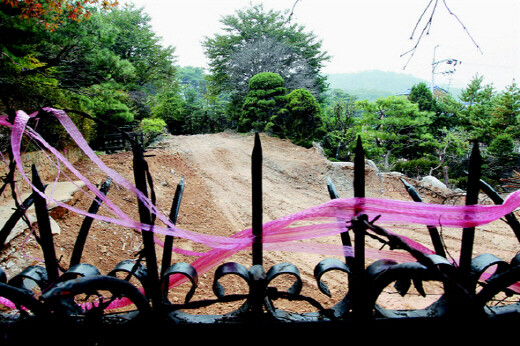hankyoreh
Links to other country sites 다른 나라 사이트 링크
[Editorial] President’s retirement residence riddled in illegalities

Controversy has been stirred by the revelation that President Lee Myung-bak is building a private residence to live in after his term in office, in the Naegok neighborhood of Seoul’s Seocho district, in the name of his son, Lee Si-hyung. The Cheong Wa Dae (the presidential office in South Korea or Blue House) scrambled to provide explanations yesterday afternoon, but this did nothing to decrease suspicions. On the contrary, the incident provides a graphic illustration of the extent to which the Cheong Wa Dae’s working methods are riddled with opportunism and deception.
The Cheong Wa Dae explained that high land prices around the president’s existing residence in Seoul’s Nonhyeon neighborhood, located in the neighboring Gangnam District, made the building of facilities for security guards difficult, and that it had therefore decided to build a new residence and security facilities. Strictly speaking, however, such behavior on the part of the Cheong Wa Dae constitutes a ‘budget diversion’. This is because the president’s office originally allocated a budget of four billion won ($3.4 million) for the building of security facilities, stating clearly that this amount was “determined according to the residence of the president currently in office.” If a reason for changing budget use has emerged, Cheong Wa Dae should state this reason before going ahead with the change.
Harder still to accept is the explanation that land was bought in the name of the president’s son, Lee Si-hyung, in consideration of security problems that may arise when building the residence. Other presidents in the past have also built themselves new residences, but they did so openly in their own names, without resorting to expedients such as this. In any case, the fact that a private residence and large-scale security facilities are being built for the president is something that soon becomes known to the public. We are truly curious as to how, in spite of this, someone came up with the strange idea of secretly building the residence in the name of the president’s son, then have the president buy it from him.
The complex flow of funds that this entails, too, remains totally unexplained. Si-hyeong reportedly took out a loan of 600 million won from the Cheong Wa Dae branch of Nonghyup Bank, using his first lady Kim Yoon-ok’s stake in Lee’s Nonhyeon neighborhood residence as collateral, then supplemented this with 520 million won in loans from relatives. There was no explanation as to how he is paying interest on loans of this debt of over 1.1 billion won. This makes controversy over illegal inheritance transfers.
The question also remains of how the enormous construction fees for the residence will be provided. Given that Lee Si-hyung reported his total assets in 2007 as amounting to around 36.5 million won, it appears that it would be hard for him even to pay the interest on his loans, let alone the construction fees. We cannot but wonder what kind of consideration Lee will provide his son when the house has been built and is transferred into Lee’s name.
The predicted profits from developing this land, too, deserve scrutiny. The land bought by Lee Si-hyung is reportedly designated as a planning zone, following the removal of its green belt designation in 2006, when Lee Myung-bak was mayor of Seoul. This really was an exquisite choice of location, since prices in this area are certain to rise sharply in future when development begins in earnest.
It is about time that Cheong Wa Dae stopped resorting to expedients and deceit that fly in the face of common sense. If not, perhaps it will help the public if we say that President Lee is building his residence using an illegal “false name.”
Please direct questions or comments to [englishhani@hani.co.kr]
Editorial・opinion
![[Column] Has Korea, too, crossed the Rubicon on China? [Column] Has Korea, too, crossed the Rubicon on China?](https://flexible.img.hani.co.kr/flexible/normal/500/300/imgdb/original/2024/0419/9317135153409185.jpg) [Column] Has Korea, too, crossed the Rubicon on China?
[Column] Has Korea, too, crossed the Rubicon on China?![[Correspondent’s column] In Japan’s alliance with US, echoes of its past alliances with UK [Correspondent’s column] In Japan’s alliance with US, echoes of its past alliances with UK](https://flexible.img.hani.co.kr/flexible/normal/500/300/imgdb/original/2024/0419/2317135166563519.jpg) [Correspondent’s column] In Japan’s alliance with US, echoes of its past alliances with UK
[Correspondent’s column] In Japan’s alliance with US, echoes of its past alliances with UK- [Editorial] Does Yoon think the Korean public is wrong?
- [Editorial] As it bolsters its alliance with US, Japan must be accountable for past
- [Guest essay] Amending the Constitution is Yoon’s key to leaving office in public’s good graces
- [Editorial] 10 years on, lessons of Sewol tragedy must never be forgotten
- [Column] A death blow to Korea’s prosecutor politics
- [Correspondent’s column] The US and the end of Japanese pacifism
- [Guest essay] How Korea turned its trainee doctors into monsters
- [Guest essay] As someone who helped forge Seoul-Moscow ties, their status today troubles me
Most viewed articles
- 1[Column] The clock is ticking for Korea’s first lady
- 2Samsung barricades office as unionized workers strike for better conditions
- 3After 2 months of delayed, denied medical care, Koreans worry worst may be yet to come
- 4[Correspondent’s column] In Japan’s alliance with US, echoes of its past alliances with UK
- 5[Column] Has Korea, too, crossed the Rubicon on China?
- 6Hong Se-hwa, voice for tolerance whose memoir of exile touched a chord, dies at 76
- 7All eyes on Xiaomi after it pulls off EV that Apple couldn’t
- 8US overtakes China as Korea’s top export market, prompting trade sanction jitters
- 9[Photo] Smile ambassador, you’re on camera
- 10[Guest essay] How Korea turned its trainee doctors into monsters